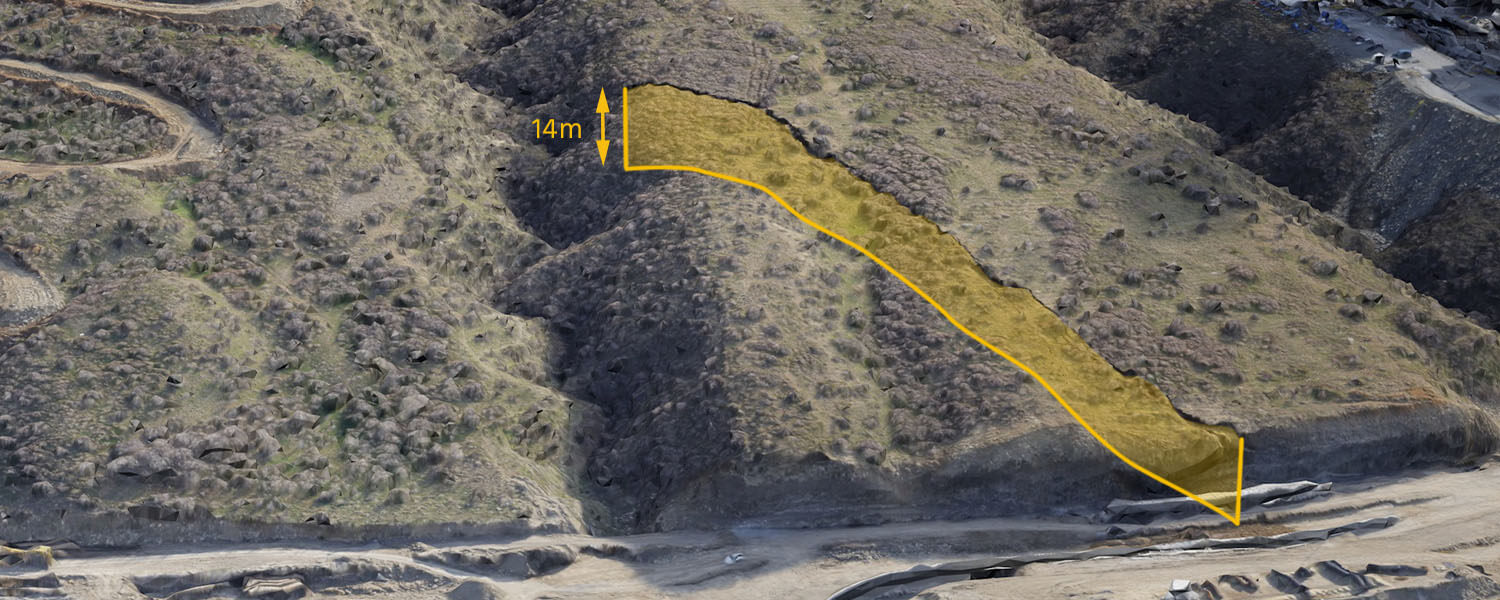When a 14 meter fissure appeared on a hillside in the Georgian capital, geological experts deployed the eBee X drone to study the landslide and help assess reinforcement operations with an aerial survey of the high-risk area.
Project Details
| Type of mission – Disaster management | Outputs – Orthomosaic, DSM |
| Area – 2,523 km2 / 252 ha / 623 ac | Total images – 889 |
| Drone – eBee X with Aeria X | Processing time – 4h30 |
| GSD – 1.6 cm / 0.6 in | Processing software – PIX4Dmapper |
| RTK/PPK – Yes | Location – Tbilisi (Georgia) |
| Flights needed – 2 | Data provided by – Vitali Machavariani, Georgian National Environmental Agency |
In March 2021 the earth broke open on the Vashlijvari slope, a hillside located near a road connecting two residential areas of Tbilisi, Georgia’s capital. The colossal size of the cracking – 14 meters deep and around half a million cubic meters of torn landmass – alerted experts to respond quickly in order to prevent the width from increasing and the slope from sliding off completely.
If a debris flow were to happen, and because of the proximity of the landslide to urban zones, people’s lives and properties were at stake.

Tbilisi City Hall collaborated with international geologists and specialists from the Georgian National Environmental Agency to overcome the challenges of this geological hazard. The first was the danger of monitoring the land subsidence, the velocity of the soil and aperture of the open surface cracks in situ all while keeping workers safe.
The other was the need for a rapid assessment of the situation and its growing risks, such as the threat of the landslide consuming the nearby road network, causing substantial cost and damage to infrastructure.

Aerial surveys with a drone for landslide mapping
The team of experts decided to use the eBee X fixed-wing drone to assess the geological hazard.
“When you have to be accurate, you choose the best possible way to achieve high-quality datasets. With the eBee X drone and the endurance battery (offering up to 90 mins of flight time) we could cover several square km per day. This means several days of savings if we surveyed with other tools”
Vitali Machavariani, from the National Environmental Agency Hydrometeorological Department.

The specialists monitored the landslide process over a few weeks. This dataset is one of the outputs generated during the study. The large area surveyed to create the orthomosaic and Digital Surface Model (DSM) was 2,523 km2 (252 ha / 623 ac). A total of 889 images were collected in two flights and processed with PIX4Dmapper in less than 5 hours.
Precision was crucial to this mission. With this in mind, the team used the Aeria X photogrammetry camera and enabled the RTK/PPK option of the eBee X drone. Four checkpoints were used to verify the georeferenced accuracy of the RTK/PPK data and achieve an overall RMS error of 1.6 cm (0.6 in).
“Without the eBee X RTK/PPK solution, it would be much more time consuming to complete the survey with quadcopters and get sufficient, reliable data for decisionmakers”, adds Machavariani.
High-resolution DSM and orthomosaic maps to assess geological hazards
“The generation of high-resolution aerial imagery with a drone is a crucial part for assessment of different types of geological hazards, combined with detailed DSM (Digital Surface Model) which allowed a detailed evaluation of the slope morphological features”, states Vitali Machavariani.
Indeed, thanks to the maps generated with the drone data, the team of experts could study the volume, curvature and movement of the landslide, to detect its direction, type, velocity, depth, and at the same time identify cracks and flow accumulation.

The eBee X mapping and the digital outputs generated with PIXDmapper were essential for the landslide’s recovery efforts, which consisted of reinforcement and drainage. In August 2021 Tbilisi Mayor proclaimed the site stabilized.
This story was sourced from an entry in the 2021 senseFly (now Arnold) & Pix4D Photogrammetry Awards, in the Disaster Management category. Check Pix4D article here.




